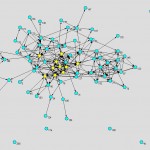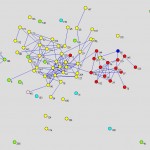I’m teaching a lecture course on Political Sociology at the moment, and because everyone is so excited about social capital and social network analysis these days, I decided to run a little online experiment with and on my students. The audience is large (at the beginning of this term, about 220 students had registered for this lecture series) and quite diverse, with some students still in their first year, others in their second, third or fourth and even a bunch of veterans who have spent most of their adult lives in university education.

Fortunately, I had a list of full names plus email addresses for everyone who had signalled interest in the lecture before the beginning of term, so I created a short questionnaire in limesurvey and asked them a very simple question: whom do you know in this group? Given the significant overcoverage of my list – in reality, there are probably not more than 120 students who regularly turn up for the lecture – the response rate was somewhere in the high 70s. If you want to collect network data with limesurvey, the “array with flexible labels” question type is your friend, but keying in 220 names plus unique ids would have been a major pain. Thankfully, one can program the question with a single placeholder name, then export it as a CSV file. Next, simply load the file into Emacs and insert the complete list, then re-import it in limesurvey.
Getting a data matrix from Stata into Pajek is not necessarily a fun exercise, so I decided to give the networkx module for Python a go, which is simply superb. Networkx has data types for representing social networks, so you can read in a rectangular data matrix (again as CSV), construct the network in Python and export the whole lot to Pajek with a few lines of code:
#Some boring stuff omitted
#create network
Lecture=nx.DiGraph()
#Initialise
for i in range(1,221):
Lecture.add_node(i, stdg="0")
for line in netreader:
sender = int(line[-1])
#Sender-ID at the very end
edges=line[6:216]
#Degree-scheme
Lecture.node[sender]['stdg']=line[-8]
#Edges
for index in range(len(edges)):
if edges[index] == '2':
Lecture.add_edge(sender,int(filter(str.isdigit,repr(knoten[index]))),weight=2)
elif edges[index] == '3':
Lecture.add_edge(sender,int(filter(str.isdigit,repr(knoten[index]))),weight=3)
nx.write_pajek(Lecture,'file.net')
As it turns out, a lecture hall rebellion seems not very likely. About one third of all relationships are not reciprocated, and about a quarter of my students do not know a single other person in the room (at least not by name), so levels of social capital are pretty low. There is, however, a small group of 10 mostly older students who are form a tightly-knit core, and who know many of the suckers in the periphery. I need to keep an eye on these guys.

Finally, the second graph also shows that those relatively few students who are enrolled in our new BA programs (red, dark blue) are pretty much isolated within the larger group, which is still dominated by students enrolled in the old five year programs (MA yellow, State Examination green) that are phased out. Divide et impera.
Discover more from kai arzheimer
Subscribe to get the latest posts sent to your email.
![Which of my students are most likely to gang up against me? 1 Reblog this post [with Zemanta]](http://img.zemanta.com/reblog_e.png?x-id=5065f66c-8fcc-401f-afbc-f04a7abf490e)

